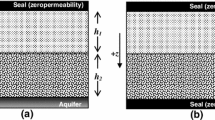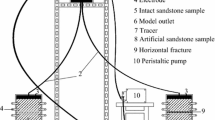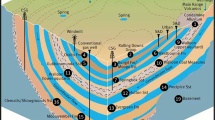Abstract
An in situ method of estimating the effective diffusion coefficient for a chemical constituent that diffuses into the primary porosity of a rock is developed by abruptly changing the concentration of the dissolved constituent in a borehole in contact with the rock matrix and monitoring the time-varying concentration. The experiment was conducted in a borehole completed in mudstone on the campus of the University of the Free State in Bloemfontein, South Africa. Numerous tracer tests were conducted at this site, which left a residual concentration of sodium chloride in boreholes that diffused into the rock matrix over a period of years. Fresh water was introduced into a borehole in contact with the mudstone, and the time-varying increase of chloride was observed by monitoring the electrical conductivity (EC) at various depths in the borehole. Estimates of the effective diffusion coefficient were obtained by interpreting measurements of EC over 34 d. The effective diffusion coefficient at a depth of 36 m was approximately 7.8×10−6 m2/d, but was sensitive to the assumed matrix porosity. The formation factor and mass flux for the mudstone were also estimated from the experiment.
Résumé
Une méthode in situ d’estimation du coefficient effectif de diffusion pour un composé chimique qui diffuse dans la porosité primaire d’une roche est développée, en modifiant brusquement la concentration du composé dissous dans un forage en contact avec la matrice rocheuse et en suivant l’évolution de sa concentration dans le temps. L’expérimentation a été réalisée dans un forage équipé dans des argilites sur le campus de l’Université de l’Etat Libre de Bloemfontein (Afrique du Sud). Plusieurs essais de traçage ont été réalisés sur ce site, laissant des concentrations résiduelles en hypochlorite de sodium dans les ouvrages, qui ont diffusé dans la matrice rocheuse au fil des années. De l’eau douce a été injectée dans un forage en contact avec les argilites, et l’augmentation temporelle de la concentration en chlorures a été observée par des mesures étagées de conductivité. L’estimation du coefficient effectif de diffusion est issue de l’interprétation des mesures de conductivité sur une période de 34 jours. Le coefficient effectif de diffusion à 36 m de profondeur est estimé autour de 7.8×10−6 m2/j, mais il apparaît sensible à la porosité évaluée. Le facteur de formation et le flux de masse issu des argilites ont également été estimés à partir de ce test.
Resumen
Se ha desarrollado un método in situ para estimar el coeficiente de difusión efectivo para un constituyente químico que sufre difusión en la porosidad primaria de una roca mediante un cambio abrupto en la concentración del constituyente disuelto en un sondeo en contacto con la matriz de la roca y monitorizando la variación de la concentración en el tiempo. El experimento se desarrolló en un sondeo completo en arcillas en el campus de la Universidad de Free State en Bloemfontein, Sudáfrica. Se han llevado a cabo numerosos ensayos de trazadores en este punto, que ha dejado una concentración residual de cloruro sódico en sondeos que han sufrido difusión en la matriz de la roca durante un periodo de años. El agua dulce se introdujo en el sondeo en contacto con las arcillas, y se observó el incremento variable en el tiempo del cloruro mediante la monitorización de la Conductividad Eléctrica (EC) a varias profundidades en el sondeo. La estimación del coeficiente de difusión efectiva se obtuvo interpretando las medidas de EC durante 34 días. El coeficiente de difusión efectiva a una profundidad de 36 m fue aproximadamente de 7.8×10−6 m2/d, pero fue sensible a la porosidad de la matriz asumida. El factor de formación y el flujo de masa para las arcillas también se estimaron a partir del experimento.








Similar content being viewed by others
References
Becker MW, Shapiro AM (2000) Tracer transport in crystalline fractured rock: evidence of non-diffusive breakthrough tailing. Water Resour Res 36(7):1677–1686
Becker MW, Shapiro AM (2003) Interpreting tracer breakthrough tailing from different forced-gradient tracer experiment configurations in fractured bedrock. Water Resour Res 39(1), 1024. DOI 10.1029/2001WR001190
Botha JF, Verwey JP, Van der Voort I, Vivier JJP, Buys J, Colliston WP, Loock JC (1998) Karoo aquifers: their geology, geometry and physical properties. Report to Water Commission. WRC Report No: 487/1/98. Institute for Groundwater Studies, Bloemfontein, South Africa
Crump KS (1976) Numerical inversion of Laplace transforms using a Fourier series approximation. J Assoc Comput Mach 23(1):89–96
Finley RJ, Tyler N (1986) Geological characterization of sandstone reservoirs. In: Lake LW, Carroll HB Jr (eds) Reservoir characterization. Academic, Orlando, FL, pp 1–38
Garnier JM, Crampon N, Préaux C, Porel G, Vreulx M (1985) Traçage par 13C, 2H, I- et uranine dans la nappe de la craie sénonienne en écoulement radial convergent (Béthune, France) [Tracing with 13C, 2H, I and uranine in the groundwater of the Senonian chalk, in a radial convergent flow (Béthune, France)]. J Hydrol 78:379–392
Hem JD (1989) Study and interpretation of the chemical characteristics of natural waters. US Geol Surv Water Suppl Pap 2254, 263 pp
Mace RE, Hvorka SD (2000) Estimating porosity and permeability in a karstic aquifer using core plugs, well tests, and outcrop measurements. In: Sasowsky, ID, Wicks CM (eds) Groundwater flow and contaminant transport in carbonate aquifers. Balkema, Rotterdam, The Netherlands, pp 93–111
Maloszewski P, Zuber A (1991) Influence of matrix diffusion and exchange reactions on radiocarbon ages in fissured carbonate aquifers. Water Resour Res 27(8):1937–1945
Novakowski KS, Van der Kamp G (1996) The radial diffusion method 2: a semianalytical model for the determination of effective diffusion coefficients, porosity, and adsorption. Water Resour Res 32:1823–1830
Novakowski K, Lapcevic P, Bickerton G, Voralek J, Zanini L, Talbot C (1999) The development of a conceptual model for contaminant transport in the dolostone underlying Smithville, Ontario, Earth Science Department, Brock University, St. Catherines, ONT, 98 pp
Ohlsson Y, Neretnieks I (1995) Literature survey of matrix diffusion theory and of experiments and data including natural analogues. Technical report 95–12, Swedish Nuclear Fuel and Waste Management (SKB), Stockholm, 89 pp
Ohlsson Y, Neretnieks I (1997), Diffusion in granite: recommended values. Technical report 97–20, Swedish Nuclear Fuel and Waste Management (SKB), Stockholm, 13 pp
Parker BL, Gillham RW, Cherry JA (1994) Diffusive disappearance of immiscible-phase organic liquids in fractured geologic media. Ground Water 32(5):805–820
Riemann K (2002) Aquifer parameter estimation in fractured-rock aquifers using a combination of hydraulic and tracer tests. PhD Thesis, Institute for Groundwater Studies, University of the Free State, Bloemfontein, South Africa
Robinson BA (1994) A strategy for validating a conceptual model for radionuclide migration in the saturated zone beneath Yucca Mountain. Radioact Waste Manage Environ Restor 19:73–96
Robinson RA, Stokes PH (1965) Electrolyte solutions. Butterworth, London
Shapiro AM (2001) Effective matrix diffusion in kilometer-scale transport in fractured crystalline rock. Water Resour Res 37(3):507–522
Van der Kamp G, Van Stempvoort DR, Wassenaar LI (1996) The radial diffusion method 1: using intact cores to determine isotopic composition, chemistry, and effective porosities for groundwater in aquitards. Water Resour Res 32(6):1815–1822
Van der Voort I (2001) Decision tool for establishing a strategy for protecting groundwater resources: data requirements, assessment and pollution risk. PhD Thesis, Institute for Groundwater Studies at the University of the Free State, Bloemfontein, South Africa
Van Tonder GJ, Vermeulen PD (2005) The applicability of slug tests in fractured-rock formations. Water SA 31(22):157–159
Van Wyk AE (1998) Tracer experiments in fractured-rock aquifers. MSc Thesis, Institute for Groundwater Studies at the University of the Free State, Bloemfotein, South Africa
Wood WW, Shapiro AM, Hsieh PA, Councell TB (1996) Observational, experimental and inferred evidence for solute diffusion in fractured granite aquifers: examples from the mirror lake watershed, Grafton County, New Hampshire. In: US Geological Survey Toxic Substances Hydrology Program, Proceedings of the Technical Meeting, vol 1, US Geol Surv Water Resour Invest Rep 94–4015:167–170
Acknowledgements
The authors wish to acknowledge the contributions of J. Pretorius, G. Van Tonder and S. Lenong for their help in conducting the field experiments at the Campus Test Site. Comments by W. E. Sanford and W. B. Shoemaker of the US Geological Survey, the Associate Editor of Hydrogeology Journal and the anonymous reviewers were instrumental in improving the content of this article. Last but not least, the authors wish to thank T. Oosthuizen for editing the figures in this manuscript.
Author information
Authors and Affiliations
Corresponding author
Appendix
Appendix
The solution for the radial diffusion of a nonreactive solute from the rock matrix to a borehole is similar to the methodology given by Novakowski and Van der Kamp (1996) for a finite volume core sample. The mass balance equation for radial diffusion in the porous rock matrix is given by:
where r is the radial coordinate measured from the centre of the borehole, c is the aqueous concentration (per unit fluid volume) in the porous matrix, t is time, D is the effective diffusion coefficient in the porous matrix for the chemical constituent under consideration, which is the product of the free-water diffusion coefficient for the constituent under consideration and a formation factor, which is inversely proportional to the tortuosity of the porous matrix, D=ϕ D d, where D d is the free-water diffusion coefficient and ϕ is the formation factor.
The initial and boundary conditions associated with Eq. (3) are
where R is the radius of the borehole, C m is the concentration in the porous matrix, which is assumed to be spatially uniform, and C w is the concentration in the fluid column of the borehole, which is also assumed to be well mixed and uniform over the length of the borehole. Eq. (4) defines the initial concentration in the porous matrix; Eq. (5) states that at large distances from the borehole, the concentration is unchanged; and Eq. (6) states that the concentration in the formation at the borehole wall is equal to the concentration in the fluid column of the borehole.
The concentration in the borehole, C w, is governed by the following balance equation for the mass of the chemical constituent in the borehole:
where A is the surface area of the borehole through which there is diffusion, V is the volume of the fluid in the borehole, and n is the porosity of the porous matrix. Equation (7) is subject to the following initial condition,
where C B is the initial concentration of the chemical constituent in the borehole.
To solve Eqs. (3)–(8), the following change in variables is applied,
and the resulting governing equations and boundary conditions are solved in the Laplace domain. Introducing Eqs. (9) and (10) into Eqs. (3)–(8) and taking the Laplace transformation yields
where p is the Laplace transform variable, and \( \overline{{c\prime }} \) and \(\overline{{C^{\prime }_{{\text{w}}} }} \) are the Laplace transforms of \(c\prime \) and \(C^{\prime }_{{\text{w}}} \), respectively.
The solution to Eq. (11) is
where the boundary conditions given in Eqs. (12) and (13) have been applied, and K 0 is the modified Bessel function of the second kind of order 0. Eq. (15) is introduced into Eq. (14) to solve for \(\overline{{C_{{\text{w}}} ^{\prime } }} \),
which in turn is introduced into Eq. (15) to yield the Laplace transform solution for the concentration in the formation at any radial distance from the borehole,
The Laplace transform for \(\overline{{C_{{\text{w}}} }} \) and \( \overline{c} \), rather than \(\overline{{C_{{\text{w}}} ^{\prime } }} \) and \( \overline{{c\prime }} \), are obtained by taking the Laplace transform of Eqs. (9) and (10) and introducing the results into the above equations to yield
From Eq. (19), the mass flux entering or leaving the borehole can also be calculated. The mass flux into or out of the borehole at a given time is defined by Eq. (7). Integrating Eq. (7) over time yields the total mass flux into or out of the borehole during the experiment,
where F is the total mass into or out of the borehole from the start of the test to time t. Taking the Laplace transformation of Eq. (20) yields
where \( \overline{F} \) is the Laplace transformation of F at time t. Introducing Eq. (19) into Eq. (21) yields
The solutions for C w, c, and F are obtained by performing the inverse Laplace transformation to Eqs. (18), (19), and (22), respectively. A numerical algorithm for performing the inversion of the Laplace transformation solution was implemented (see, e.g., Crump 1976) to identify C w(t), c(t), and F(t).
Rights and permissions
About this article
Cite this article
Gebrekristos, R.A., Shapiro, A.M. & Usher, B.H. In situ estimation of the effective chemical diffusion coefficient of a rock matrix in a fractured aquifer. Hydrogeol J 16, 629–639 (2008). https://doi.org/10.1007/s10040-007-0255-0
Received:
Accepted:
Published:
Issue Date:
DOI: https://doi.org/10.1007/s10040-007-0255-0




